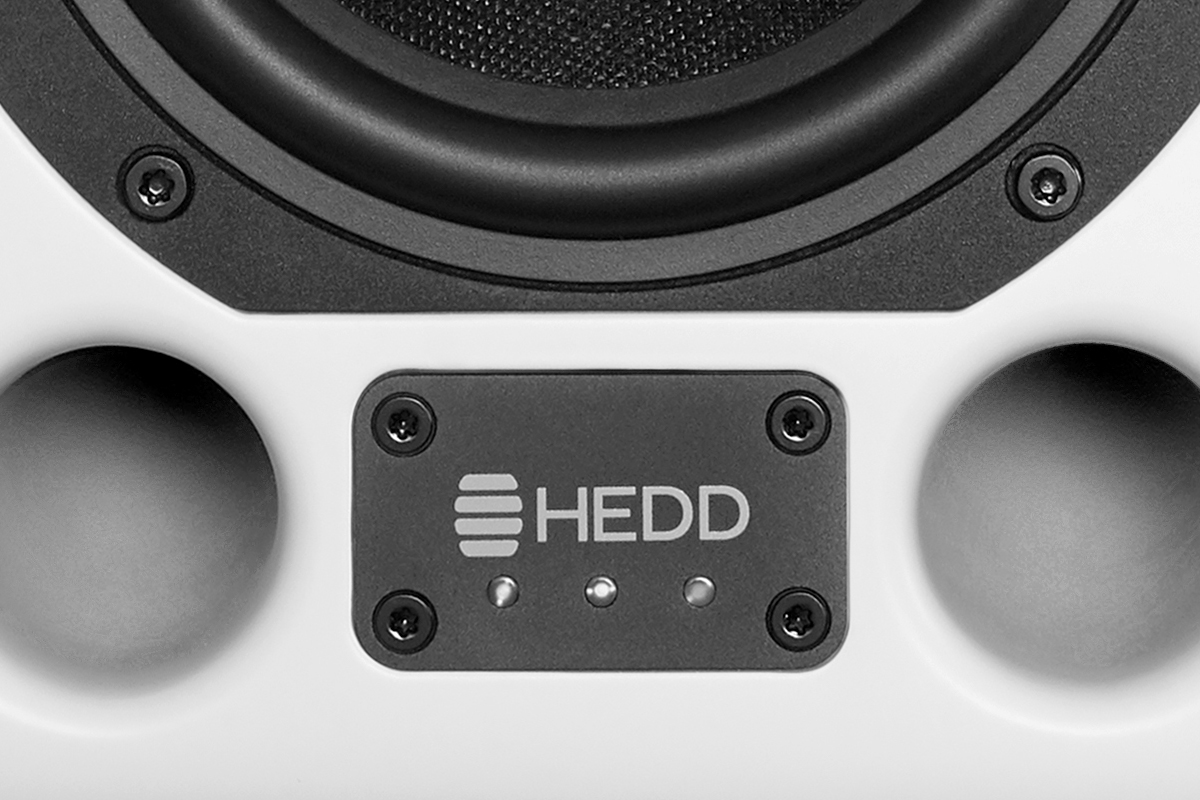In the past two years I’ve reviewed active studio monitors from Heinz Electrodynamic Designs (HEDD), Focal, and PMC. As you’d expect, all of these speakers work wonderfully for desktop audio. But what about listening Simplifi’d style: sitting on a sofa or comfy chair, cueing up music with a tablet or smartphone, and playing it from a streaming DAC connected to the speakers?
In my June 2020 review of HEDD’s Type 07 two-way studio monitor, I asked, “Can a speaker designed for use as a professional nearfield studio monitor work well for sit-down living-room listening?” My answer to that admittedly rhetorical question was “a resounding yes.” I said that “I admired the crystalline clarity of the Type 07’s [Air Motion Transformer] tweeter, which made it sound fast, agile, and articulate. These speakers could also rock—the Type 07s had no trouble filling my main-floor living area with big, dynamic sound that was always a delight to listen to.”
In January, Berlin-based HEDD announced new versions of its studio monitors, and two new powered subwoofers: the Bass 08 ($1199, all prices USD) and Bass 12 ($2399).
The new monitors and subs feature HEDD’s Closed or Ported (CoP) technology. By default, they work as bass-reflex speakers. But each model can be converted to sealed operation by inserting the supplied plugs into its bass ports and turning the CoP knob on the speaker’s rear panel from Ported to Closed. Ported mode provides higher output and deeper bass, HEDD says, while Closed provides greater clarity and more precise transients. In Closed mode, the maximum SPL at low frequencies is 6-10dB lower than in Ported mode, HEDD says.
For its first-generation monitors, HEDD offered their free Lineariser app, which could be used to optimize the phase response. Lineariser could operate as a plug-in for a professional digital audio workstation (DAW), or be configured as a standalone program for macOS or Windows, processing output from a music-player app before routing it to a connected DAC.
In HEDD’s new subs and monitors, the Lineariser function is implemented by the speaker’s digital signal processor (DSP)—no separate app is required. To engage Lineariser, just turn the Lineariser knob on the back of the speaker to On. Per HEDD, Lineariser delivers more precise imaging and clearer transients.
In HEDD’s monitors, Lineariser adds a time delay of 10-20 milliseconds; in the subs, a delay of 30-40ms. With Lineariser enabled on both subwoofer and satellites, total system delay is 30-40ms. This will probably not be a problem when listening to music, but for movies or games you’ll want to turn Lineariser off—especially if you’re using the sub—in order to get precise synchronization of audio to video.
Lineariser applies switchable group delay to the subwoofers’ analog outputs. Working with the Lineariser function in the monitors, this makes possible a phase-linear satellite-subwoofer system. I found this prospect very tantalizing, and asked HEDD to provide a system comprising the Bass 08 and a pair of their smallest monitors, the Type 05 MK2.
Description: Type 05 MK2
Like all HEDD monitors, the Type 05 MK2 employs an Air Motion Transformer (AMT) tweeter. Whereas a conventional cone or dome tweeter pushes air forward (and backward) pistonically to create soundwaves, an AMT moves air by squeezing and expanding a pleated diaphragm in accordion fashion. Audio signals are sent to conductive tracings embedded in this diaphragm, which is suspended in a magnetic field.
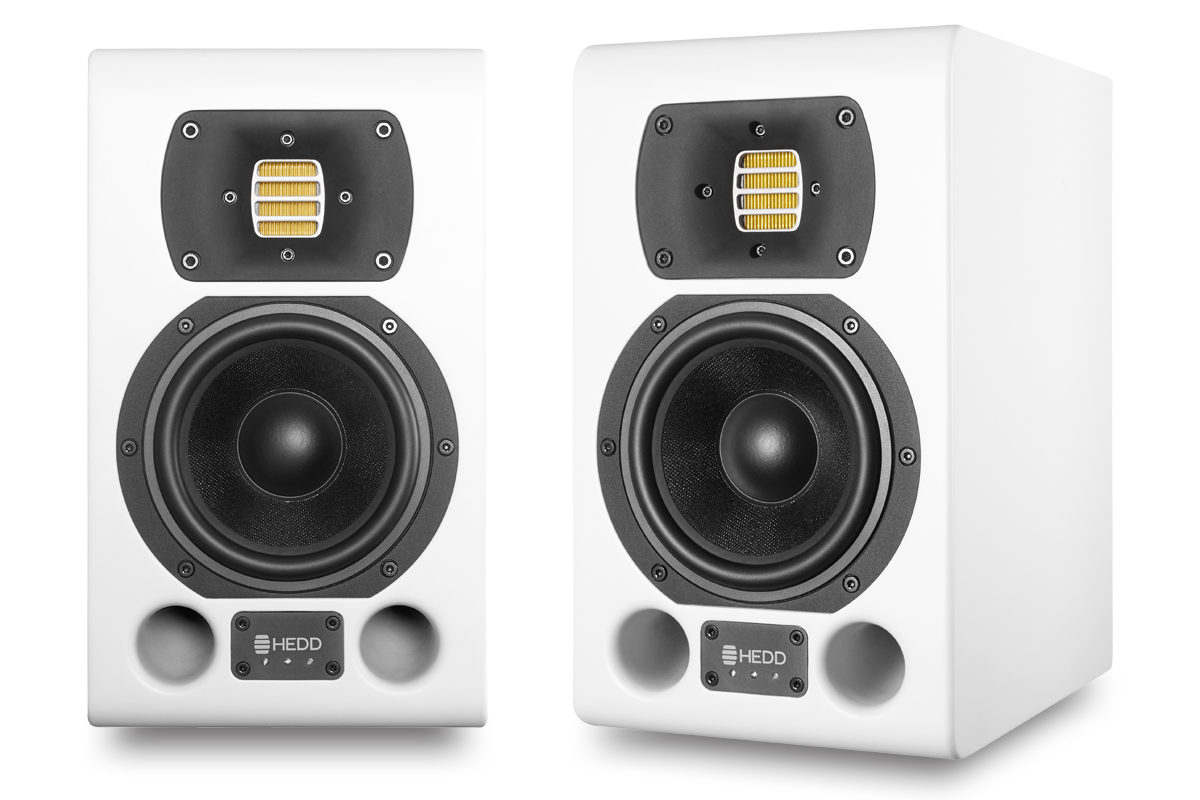
According to HEDD, an AMT delivers higher output and faster transient response than a conventional dynamic tweeter. HEDD also says that its AMTs improve on earlier designs through the use of powerful neodymium magnets that permit higher output at lower distortion, and a plastic waveguide that makes possible a lower crossover frequency.
The Type 05 MK2’s AMT is crossed over at 2.5kHz to a 5″ midrange-woofer with a honeycomb cone and a 1.5″ voice coil. The slope of the DSP-based crossover is unusually steep: 48dB/octave. Each driver has its own 100W ICEpower class-D amplifier.
Each Type 05 MK2 measures 12.2″H x 7.1″W x 9.6″D and weighs 14.11 pounds, and is available in a lacquer finish of black satin for $1598/pair; for white satin, add $120/pair. The top and bottom edges of the front baffle gracefully curve to become the speaker’s top and bottom surfaces. There is no grille.
At the top of the baffle is the AMT tweeter, its gold-colored diaphragm showing through the slots of its gray front magnet/pole plate—the entire AMT assembly nestles inside the waveguide. Below that is the 5″ midrange-woofer, and at the bottom of the baffle is a badge bearing the HEDD logo and three LEDs that indicate the system status: green for power-on, white for standby, red for overload. To either side of the logo is one of two bass ports. On my review samples, the deep-black tweeter waveguide, midrange-woofer cone and basket, logo, and (when in place) port plugs contrasted dramatically with the smooth white satin of the cabinets.
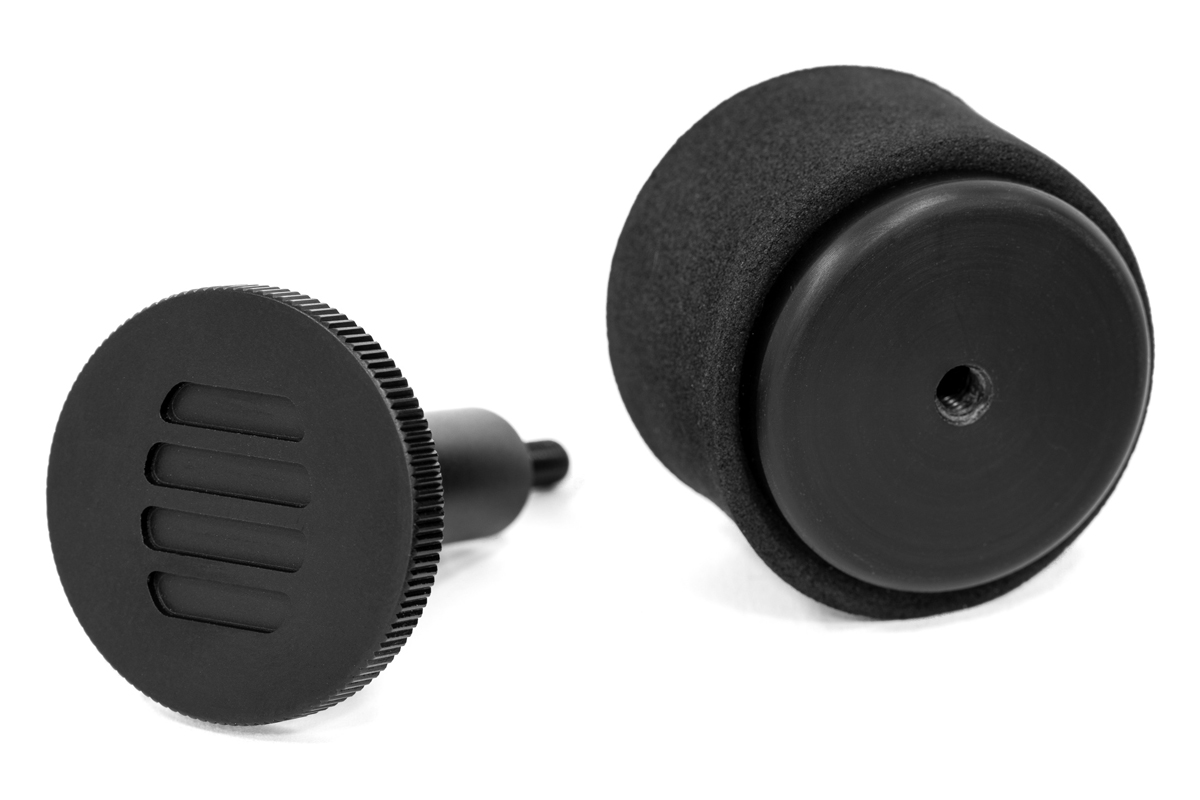
At the bottom of the rear panel are an on/off rocker and a three-pronged IEC power inlet; to their right is an RJ45 port labeled “Factory Use Only.” Above these are the inputs and output: balanced analog in and AES digital in (both on XLR females), and AES digital passthrough (XLR male). Maximum resolution of the AES inputs is 32-bit/96kHz. Analog signals are converted to 32/96 PCM before being passed along to DSP.
Above those connectors are three rows of three knobs each. In the top row is a volume knob with a range of -12 to +12dB, in 1dB increments; and, as mentioned above, the knobs for enabling/disabling Lineariser and selecting between Ported and Closed operation. The CoP control changes the filtering performed by the speaker’s DSP chip.
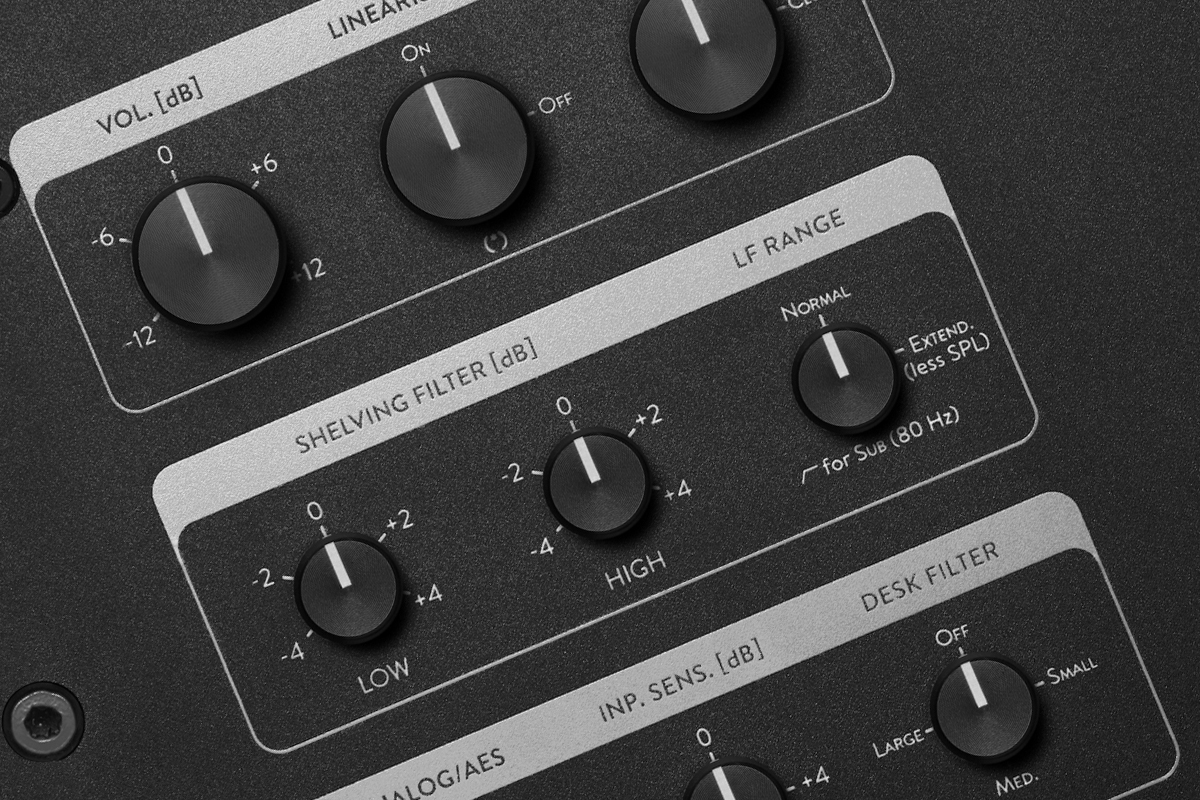
Below these are Low and High Shelving Filters and an LF Range control. Low Shelving provides ±4dB adjustment of frequencies below 200Hz, and High Shelving ±4dB adjustment of frequencies above 3kHz, both in 1dB increments. LF Range has three settings: In Normal mode, the Type 05 MK2’s specified frequency response is 45Hz-40kHz, -3dB, and its maximum SPL is 112dB/pair. Extended (Less SPL) mode lowers the speaker’s -3dB point to 36Hz, but also reduces the maximum SPL by 6dB, to 106dB. You select the Sub (80Hz) option if you’re mating the Type 05 MK2 with one of HEDD’s subwoofers, or a sub from another manufacturer. I’ll explain its operation in greater detail in the Setup I section.
From left to right in the third row of knobs, each of which has four settings, are: Analog/AES input (Analog, AES Left, AES Right, AES Mono); Input Sensitivity (-10, -4, 0, +4dB); and Desk Filter (Small, Medium, Large, Off). Input Sensitivity is used to optimize the signal/noise ratio for the A/D converter that processes analog signals—I left this at its factory setting of 0dB throughout my listening. Desk Filter is used to engage parametric EQ filters that can compensate for early reflections of soundwaves off of mixing desks of the range of sizes indicated by the settings.
Description: Bass 08
The Bass 08 subwoofer is a big, black, plain-Jane box measuring 15.4″H x 11.4″W x 15.8″D and weighing 37.5 pounds. As on the Type 05 MK2, the top and bottom edges of the 08’s baffle curve gracefully back to become the top and bottom surfaces. The black-satin finish is attractive, but shows fingerprints easily. No grille is available.
On the baffle is an 8″ cone with honeycomb cone and 2″ voice coil, powered by a 300W ICEpower class-D amplifier. Below the cone are two round ports, one to each side of the logo badge.
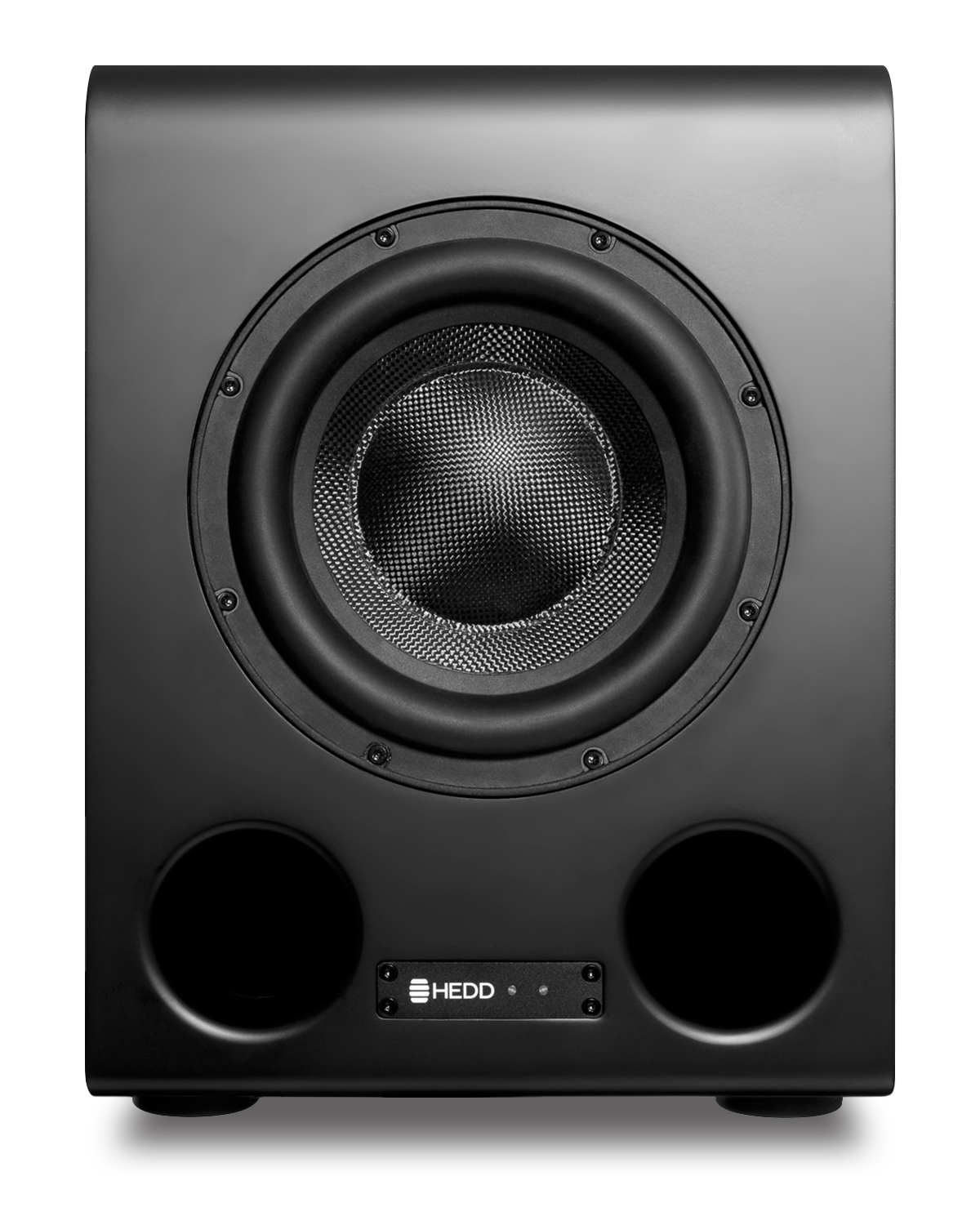
Around back are jacks and controls similar to those on the Type 05 MK2. At bottom right are the on/off switch and three-pronged power inlet, and to their left an RJ45 port marked “Factory Use only.”
The subwoofer’s input and output jacks are at bottom left. At far left is an AES digital input (XLR female), below it an AES output (XLR male). To their right are left and right balanced analog inputs (XLR female), and below them left and right balanced analog outputs (XLR male). As on the Type 05 MK2, analog signals are converted to 32/96 PCM. Analog audio output is high-pass-filtered at 80Hz, and also delayed when Lineariser is engaged—the preferred, I think, way of using the Type 05 MK2 and Bass 08 together.
Like the Type 05 MK2, the Bass 08 has three rows of three knobs each, but only the top row is identical to the speaker’s: Volume, Lineariser On/Off, and CoP.
In the second row of three knobs, Satellite Offset lets you compensate for various distances of subwoofer from satellites, within a range -2m (sub is 2m closer to the listener than sats) to +2m (sub is 2m farther away), in 0.5m increments. This adjusts the delay of the analog signal sent to the sats through the sub’s balanced outputs.
The X-Over knob lets you adjust the sub’s low-pass filter over a range of 40-120Hz in 10Hz increments. There’s also a 200Hz LFE setting, in which a low-pass filter is not engaged. The LF Range knob has Normal and Extended (less SPL) settings, plus an option that increases the output by 10dB when the crossover is set to 200Hz LFE. Extended lowers the -3dB point from 24 to 19Hz, but reduces the maximum SPL. In Normal mode, the sub’s maximum SPL when placed against a wall (i.e., in half space) is 105dB at 1m.
The bottom row of knobs are Analog/AES input selector and Input Sensitivity, whose operations are the same as those on the Type 05 MK2; the third knob, Phase, has four settings: 0°, 90°, 180°, and 270°.
As you’ll read below, these controls let me get an entirely satisfying blend of the outputs of the Bass 08 and Type 05 MK2s.
Setup I
HEDD provides Quickstart Guides with the Type 05 MK2 and Bass 08, but no printed manuals. The Operation Manual for the Type 05 MK2, available on HEDD’s website, is much more detailed, and worth downloading. But while the Bass 08’s Quickstart Guide advises the owner to “Please download and read the full manual for more information,” at time of writing HEDD still had not produced a manual for the subwoofer.
My main goal for this review was to use the Type 05 MK2s and Bass 08 as a sat-sub system for sit-down living-room listening. I placed the monitors on 28″H Monoprice Monolith speaker stands, on either side of our living room’s white fake fireplace, their rear panels 16″ from the wall behind them. That put them 7′ apart, and 7ʹ from the sweet spot: the end cushion of our sectional sofa against the opposite wall. The Bass 08 subwoofer was also on the front wall, just to the left of the right speaker. Because the sub, too, was now almost exactly 7ʹ from the sweet spot, I left its Satellite Offset knob set to 0m.
Perched atop my black speaker stands, the white Type 05s blended well with our décor, in a funky kind of way. I loved how they looked in our living room, and so did my design-conscious better half.
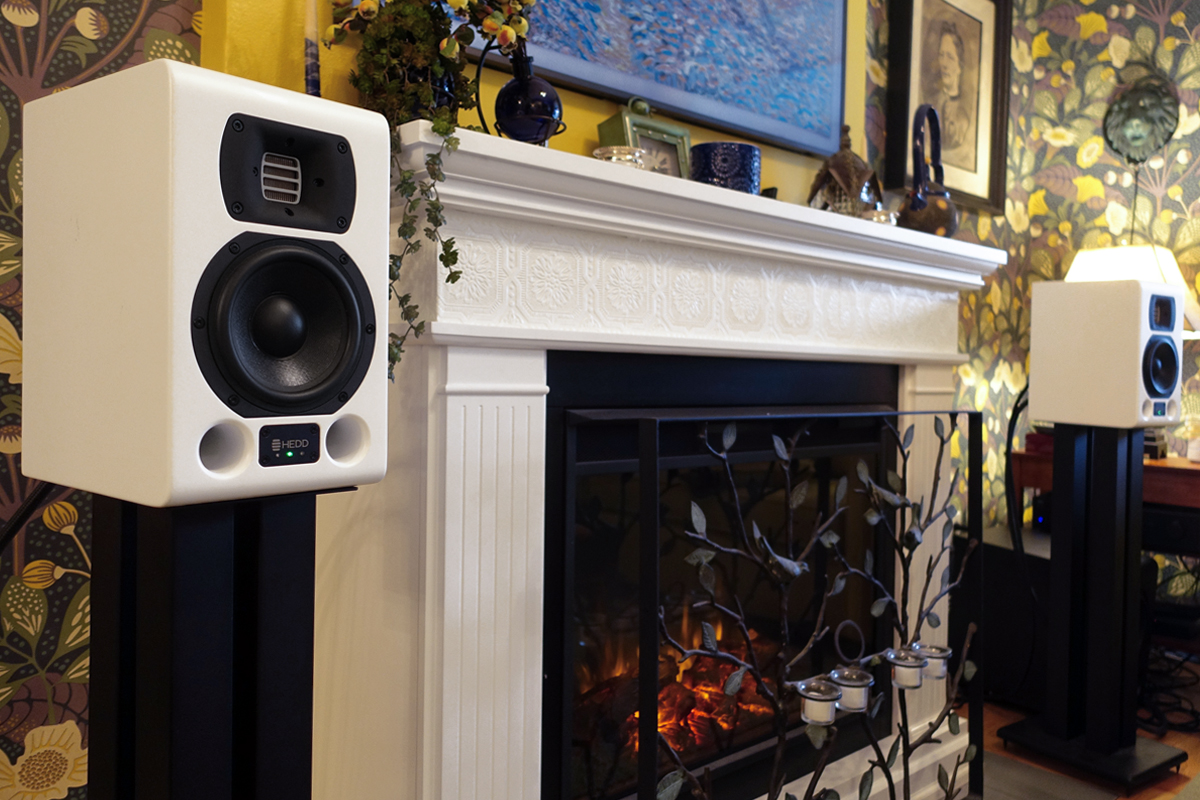
I connected the Bass 08’s XLR inputs to the XLR outputs of my NAD C 658 streaming-DAC preamp ($1649), and the sub’s XLR outputs to the analog XLR inputs of the two Type 05 MK2s. I left the subwoofer’s LF Range control in normal mode.
The Quickstart Guide for the Type 05 MK2 says the purpose of the “for Sub (80Hz)” setting on the LF Range controls is to “cut off the bass for use as satellites with subwoofers.” That phrase led me to believe that the “for Sub” setting engages an 80Hz high-pass filter on the monitors. So, it made sense to leave the LF Range control set to Normal when connecting the monitors to the analog outputs of the Bass 08. As noted above, those outputs are high-pass filtered at 80Hz, and it would obviously be undesirable to cascade two high-pass filters.
In fact, the “for Sub (80Hz)” setting does not implement a high-pass filter on the monitors. As Dmitry Grigoriev, an R&D engineer for HEDD, explained in an e-mail exchange, this setting performs phase correction for the high-pass filter on the Bass 08’s analog outputs, so that the phase response of the subwoofer and satellites are linear. This is spelled out in the Operation Manual for the Type 05 MK2. “The text in the Quickstart Guide is maybe not the best choice,” Grigoriev acknowledged. “We will adjust the text so it is more clear.” So after some trial and error, I set the satellites’ LF Range controls to “for Sub” for my first round of listening.
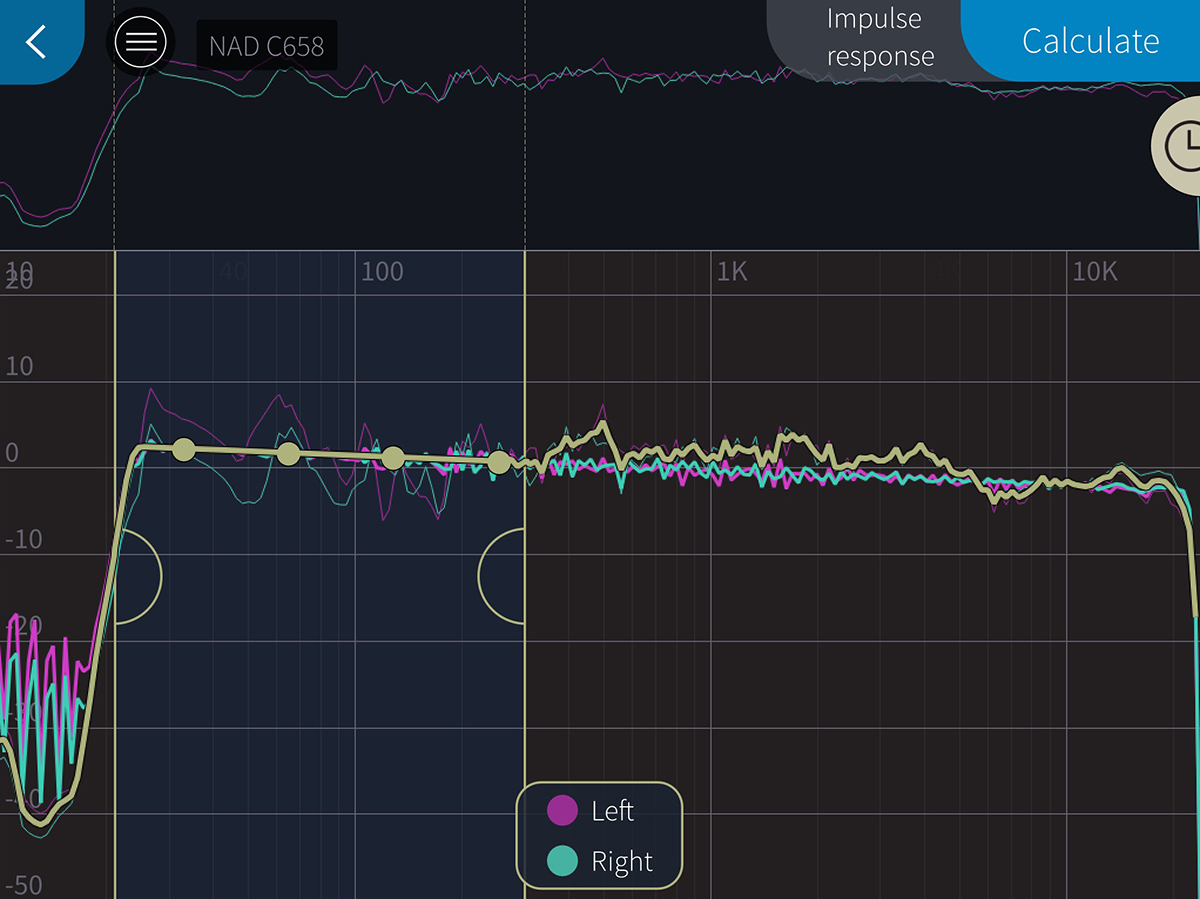
The NAD C 658 has Dirac’s Live room-correction software built-in. Wanting to hear the HEDD sat-sub system, and not the peaks and dips caused by room modes in my listening space, I ran Dirac Live twice: once with the Type 05 MK2s and Bass 08 in Closed mode, and again with the two speakers in Ported mode. (I didn’t bother with any mix-and-match experiments.) I wanted Dirac to smooth out only the low-frequency peaks and dips caused by room modes, so I limited correction to frequencies below 300Hz, and saved both correction curves to the C 658. The Dirac Live curve for Ported mode is shown above.
I briefly experimented with the Lineariser feature. With Lineariser engaged on the monitors and subwoofer, and the monitors’ LF Range controls set correctly, the sound was slightly more coherent—everything jelled together more completely. Even more striking was the portrayal of space. The soundstage was wider and deeper, and individual elements were located a little more precisely. Lineariser provided a more complete sense of the recording venue. As I was listening only to music, I left Lineariser turned on throughout my listening.
There was one ongoing operational annoyance. If the speakers had gone into standby, the sub would wake up quickly when I resumed playing music—but the speakers took more than 25 seconds to emerge from standby. All I heard in the interim was a growling sub. But when the entire system was alert, I really liked what I heard.
Listening I
When I’m listening to a new component, I like to start with a good recording of a jazz piano trio, partly because it’s a form I really like, but mainly because it tells me a lot about the product I’m testing. So it proved with the HEDD sat-sub combo when I played “Moor,” from When Will the Blues Leave, a recording of a 1999 concert in Lugano, Switzerland, by pianist Paul Bley, double bassist Gary Peacock, and drummer Paul Motian, all of whom have since passed on (16-bit/44.1kHz FLAC, ECM/Qobuz).
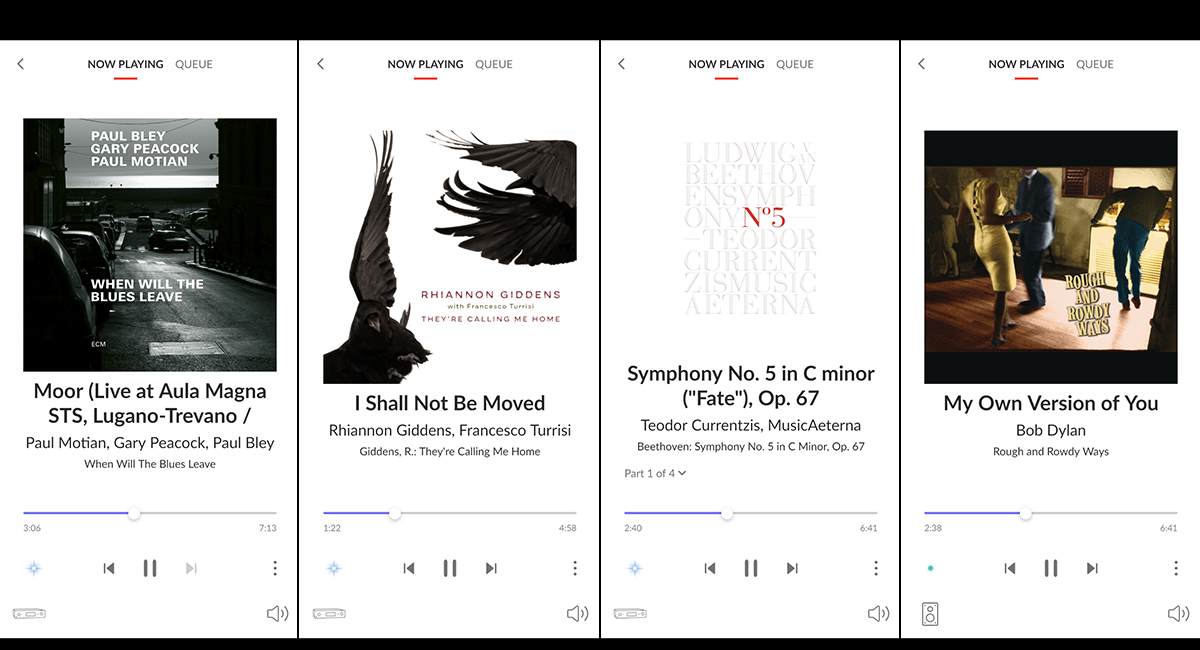
I began with the Type 05 MK2s and Bass 08 both in Ported mode. This frenetic, high-energy number begins with a long solo by its composer, Peacock, with Motian adding deft hi-hat taps. This sat-sub combo nailed this section. The sound of Peacock’s bass was big and robust right down to the lowest notes, and wonderfully articulate and tuneful. The HEDD system made it easy to appreciate his varied pizzicato attacks—some hard and fast, some with strings vibrating against the fingerboard, others plucked more softly. These attacks segued beautifully into the woody resonance of the instrument’s soundbox. Except for the extra bass extension and slam the Bass 08 provided, I was never the least bit aware of the subwoofer. Peacock’s bass was locked at left center of the soundstage, and never wandered from that spot. This may be the best blend of a pair of minimonitors and a subwoofer that I’ve ever heard.
I also loved the way the Type 05 MK2s reproduced Motian’s hi-hat, beautifully differentiating the varied sounds of the two cymbals, depending on their positions relative to each other—which depended on how far Motian had depressed the pedal when his stick struck metal. In later passages, when Motian strikes the hi-hat, ride cymbal, triangle, and other metal instruments whose names I don’t know, there was never a hint of splashiness, just a beautiful metallic sheen portraying each surface’s different sound. That AMT is a great tweeter.
At about 1:28 Bley enters on piano, quietly at first, then ramps up the drama, and here the HEDD setup showed its microdynamic chops, making it easy to appreciate his legato touch and creative pedaling. And when he pressed the sustain pedal, his notes decayed beautifully into the acoustic of the Aula Magna di Trevano.
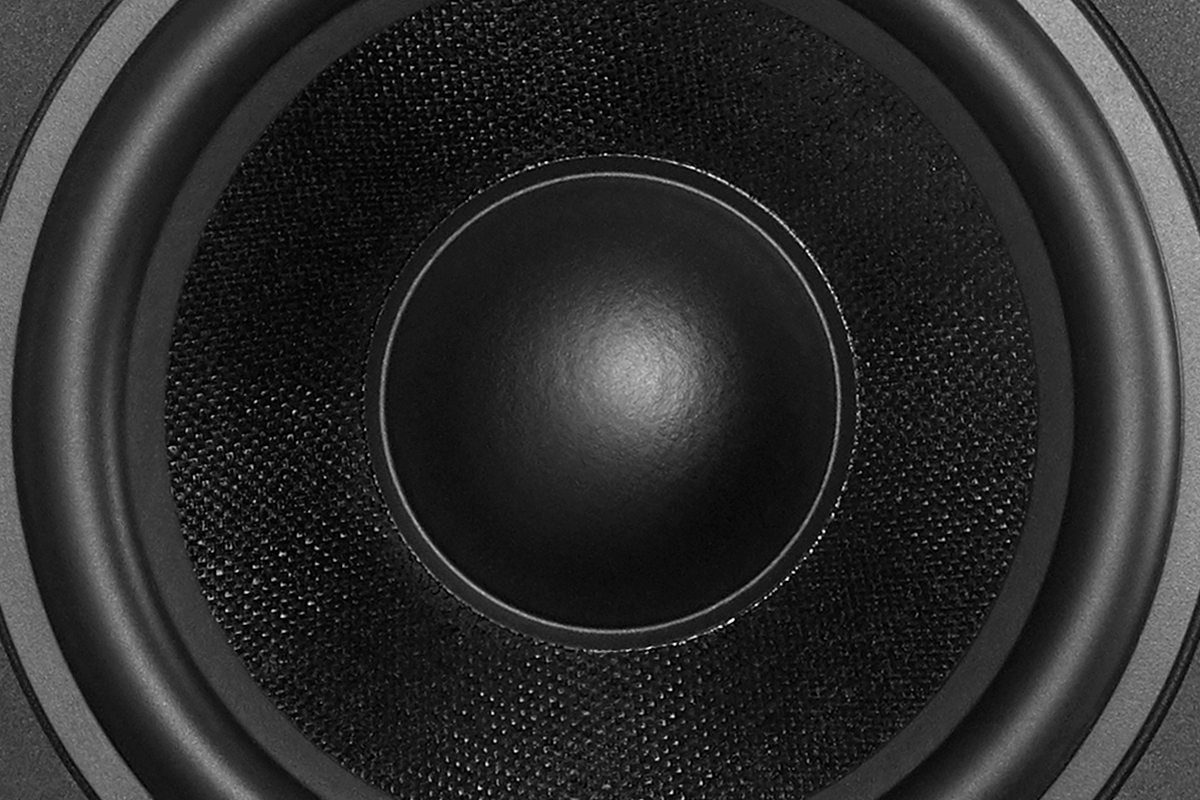
In Closed mode, Peacock’s bass sounded leaner and more detailed, but also less full and robust. While I enjoyed the greater texture of Closed, I missed the richness of Ported mode, which I preferred overall. Bley’s piano attacks in the lower and middle registers sounded a bit faster in Closed mode, a little more rounded in Ported—here, it was a toss-up. Even though each switchover took about a minute, the differences between Closed and Ported mode were clearly audible, if not huge. This is an area in which individual preferences will definitely vary; it’s nice to have both options. For the rest of my living-room listening, I left subwoofer and satellites in Ported mode.
Listening to “I Shall Not Be Moved,” from Rhiannon Giddens’s new roots album, They’re Calling Me Home (24/96 FLAC, Nonesuch/Qobuz), what most struck me was a wonderful neutrality through the midband, evinced by how the HEDDs reproduced Giddens’s rich soprano voice and resonant, low-pitched minstrel banjo—both sounded completely natural. Equally notable was the way the Type 05 MK2s placed both at the center of the soundstage, the voice a little above and behind the banjo, just as they would be in person.
Giddens’s partner and collaborator, Francesco Turrisi, punctuates each bar with a single stroke on a tan-tan, a low-pitched Brazilian hand drum. Those tan-tan beats were anchored at the right side of the soundstage, with attacks that sounded convincingly like the heel of Turrisi’s hand gently striking the drumhead, followed by the rich, resonant decay of the sound of the drum’s body—a testament to these speakers’ excellent macro- and microdynamics. Again, the blend of sats and sub was ideal—I was never aware of sounds coming from the subwoofer.
On the left side of the soundstage, Turrisi plays a chitarra battente, a small, guitar-like instrument originating in southern Italy, with five double courses of strings, the two strings of each course tuned to the same pitch. It has a lovely ringing tone, and the HEDDs’ AMT tweeters nailed it. High notes combined ringing clarity and woody resonance, and never sounded etched or spotlit.
With the iconic first movement of Beethoven’s Symphony No.5, in a riveting, high-energy performance by the MusicAeterna Orchestra led by Teodor Currentzis (24/96 FLAC, Sony Classical/Qobuz), the Type 05 MK2s again displayed outstanding soundstaging and imaging. The strings were arrayed across the front: first violins on the far left, second violins on the far right, and between them the violas, double basses, and cellos. The HEDD system differentiated these groups clearly while presenting the sound as an organic whole.
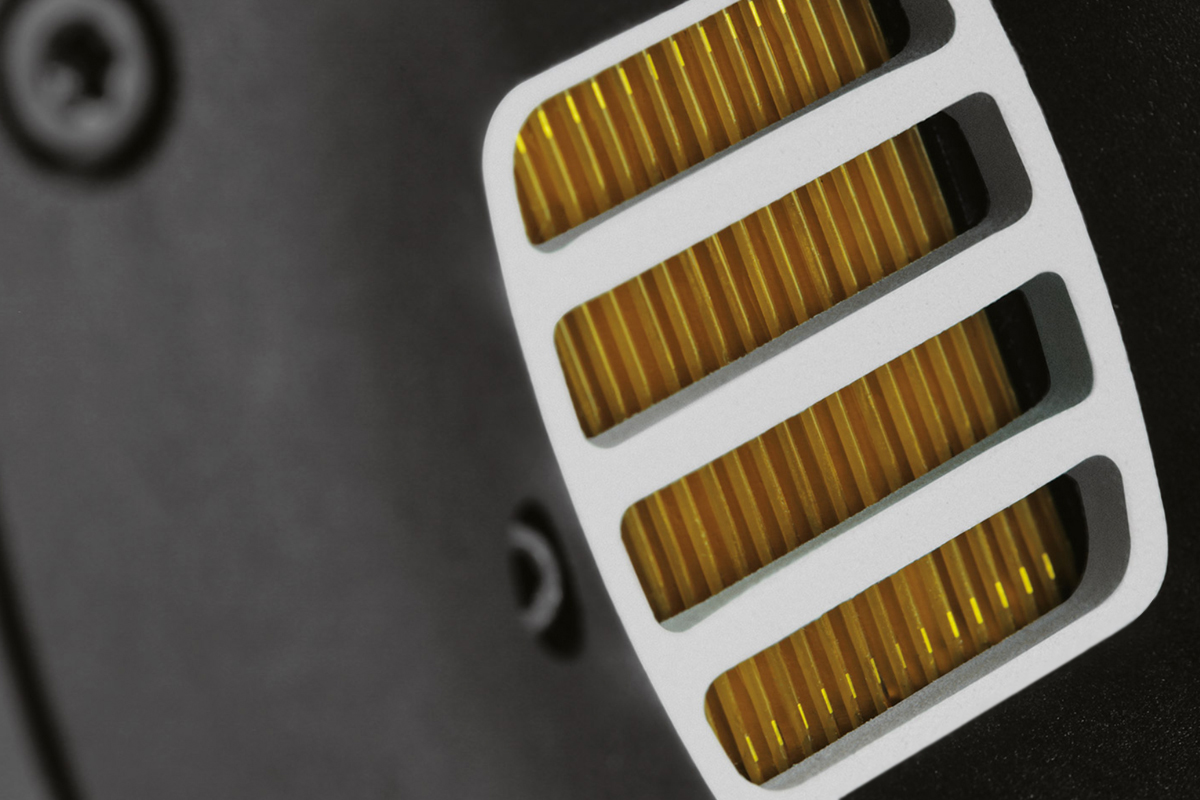
String tone was marvelous. Violins were sweet, with wonderful extension, and not at all steely. I could hear the action of the bows’ rosined horsehairs on the strings, but the sound was never scrapy. Cellos and basses sounded big and breathy, but also had delicious growl and rosiny bite. The balance was perfect: the low-pitched strings were rich and resonant, not the least boomy, and were locked in place at the center of the soundstage—another testament to the superb blend of the outputs of satellites and subwoofer.
I was just as impressed with the natural timbres of the wind instruments playing behind the strings. The horns, on the right, had delicious metallic blat. I admired the reedy, plaintive tone of the oboe in its long solo mid-movement. Front-to-back layering was superb—the winds were clearly behind and slightly higher than the strings.
Again, I was struck by this system’s dynamics, macro and micro. Timpani strokes jumped out from the left rear of the soundstage, and in reproducing tutti crescendi, the HEDD sat-sub system scaled up effortlessly. Throughout the symphony, Currentzis directs his players to execute sudden swells and diminuendi—the HEDDs tracked these expressive touches beautifully.
The sound was massive. Aided by the sub, the Type 05 MK2s conveyed the scale and power of a full orchestra playing in a big hall—in this case, Vienna’s Konzerthaus.
Comparison
I compared the HEDD sat-sub system with my Elac Navis ARF-51 active floorstanding speakers ($4599.96/pair), also connected to the NAD C 658’s balanced outputs. Again, I used Dirac Live room correction and limited the target curve to 300Hz and below, so that I’d be comparing the sound of two speaker systems. For this comparison, I used a pink-noise test tone and a handheld sound-pressure meter to match the levels to within ±0.5dB.
With “Moor,” from the Paul Bley Trio, when Gary Peacock played on the middle and upper strings, his bass sounded as robust and well defined through the Elacs as it did through the HEDD sat-sub combo. But the Elacs began to flag a bit when he played on the lower strings, sounding not only fainter but flabbier. The sound was still very satisfying, but not as crisp or robust as with the HEDD setup.
Otherwise, it was a coin toss. I enjoyed the reproduction of Paul Motian’s drum kit and Bley’s piano equally through both sets of speakers.
Rhiannon Giddens’s voice in “I Shall Not Be Moved” sounded a little more full and embodied through the Navises, perhaps because they have dedicated midrange drivers. But through the HEDDs, the transients of Francesco Turrisi’s tan-tan were crisper, and better differentiated from the ensuing resonance of the drum’s body. Giddens’s minstrel banjo sounded richer through the Elacs, but Turrisi’s chitarra battente had more ringing clarity through the HEDDs.
String tone in the Beethoven symphony was a tad harder through the Elacs, and a little less breathy. Violins didn’t sound as sweet, or have as much extension. The sound of the orchestra was a bit less transparent, a bit more homogenized, and the Elacs didn’t as clearly resolve Currentzis’s expressive dynamic shifts. Percussion attacks weren’t quite as crisp. The apparent space reproduced was bigger and more majestic through the HEDDs.
Setup II
For the second, briefer, part of my listening, I set the HEDD Type 05 MK2s atop IsoAcoustics ISO-155 desktop speaker stands at each end of the top shelf of the secretary in my second-floor office, so that I could assess their suitability for desktop audio. The speakers were 3′ apart, and described an equilateral triangle with my listening position when I sat in my office chair and leaned back. The speakers’ rear panels were 4″ from the wall behind them. So that I could listen with the tweeters at ear level, as recommended in the Operation Manual, I inverted the speakers.
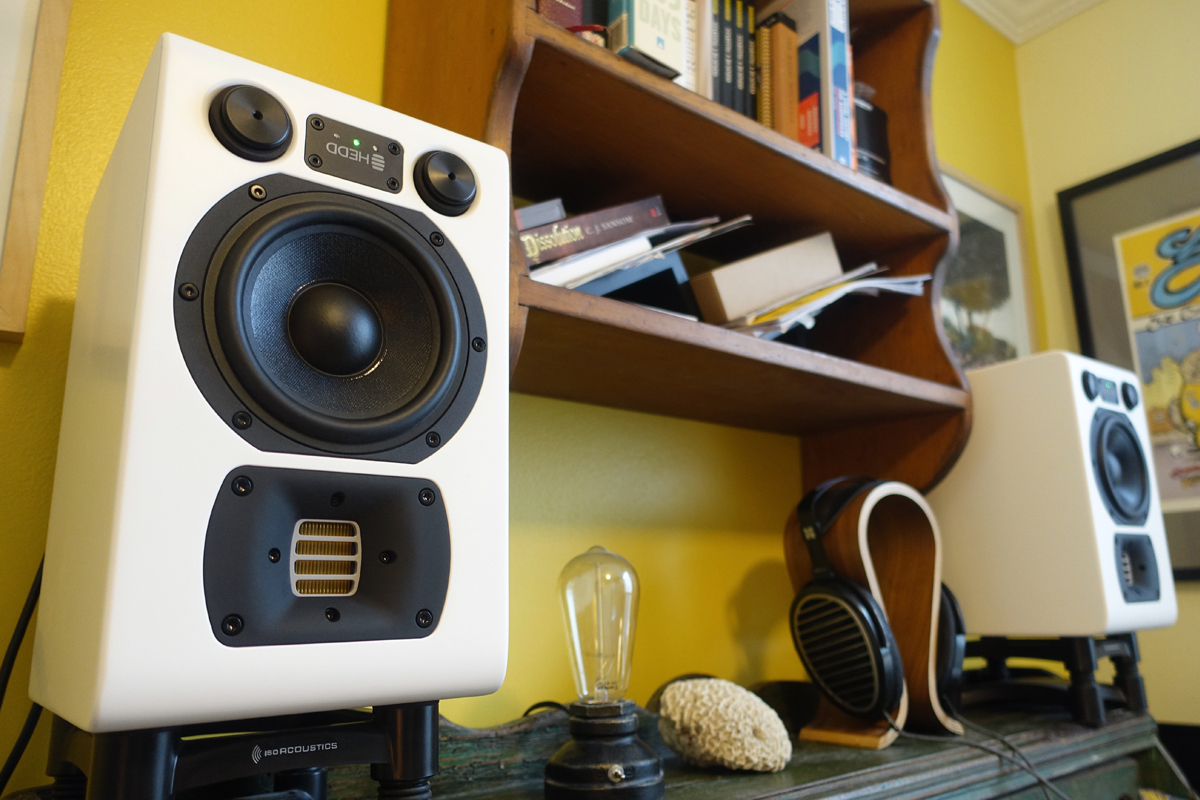
I connected the monitors’ balanced analog inputs to the balanced outputs of an exaSound e32 Mk.II DAC ($2499, discontinued), which I connected to my MacBook Pro, and played music from the Roon Control and Audirvana apps.
Listening II
I began by comparing the HEDDs’ Ported and Closed modes while playing the Paul Bley Trio’s “Moor.” As I’d experienced in my living-room listening, Peacock’s double bass sounded fuller and richer in Ported mode, leaner and more articulate in Closed mode.
I used the same track to compare the Normal and Extended LF Range modes. In Extended mode, the lowest notes of Peacock’s bass were a little more robust and a bit better defined. These differences, however, were very subtle. In my small office, the reduced maximum SPL of Extended mode wasn’t a problem.
To hear how the Type 05 MK2s reproduced male voices, I cued up “My Own Version of You,” from Bob Dylan’s Rough and Rowdy Ways (24/96 FLAC, Columbia/Qobuz). I really liked the reproduction of Dylan’s nasal baritone. Microdetail was excellent—the HEDDs captured every snarl, every shift in pitch, every gravelly inflection.
One negative was the sound of Tony Garnier’s electric bass pounding out a bold triple-time beat. From the top of my secretary, with the monitors only a few inches from the wall behind them, it sounded a little thuddy and indistinct. Switching to Closed mode tightened things up. Setting the LF Shelving control to -2dB and the Desk Filter setting to Small cured the thuddiness entirely.
Having dialed in the settings that worked best on my desktop—CoP set to Closed, LF Range to Extended, Shelving Filter Low to -2dB, Desk Filter to Small—I ended much as I’d begun, with some favorite music for jazz piano trio: “I Fall in Love too Easily”/“The Fire Within,” from Keith Jarrett’s At the Blue Note (16/44.1 FLAC, ECM/Qobuz). It sounded fantastic. Jarrett’s piano had wonderful sparkle in the upper octaves and solid heft in the lower octaves. Staccato attacks were lightning fast, legato sections wonderfully nuanced. Occasionally, though, piano tone got a bit clangy.
Gary Peacock’s bass—he played this gig too, five years before the Bley concert—had gobs of texture, yet sounded full and robust. Jack DeJohnette’s floor-tom strokes had such marvelous palpability that I could clearly hear each initial impact of mallet on drumhead, and then the body’s resonant decay. What really impressed me was the reproduction of space: Although the HEDDs were only 3′ from each other and from me, they generated a sense of hearing this music in that legendary Greenwich Village jazz club.
Conclusion
Given HEDD’s heritage, it’s no surprise that I found the Type 05 MK2 monitors so satisfying for desktop audio. For this application, you’ll need a DAC with balanced outputs, such as the exaSound e32 Mk.II I used for this review, or a digital source with AES outputs. Of course, you can adapt other source components to work with the HEDD monitors. RCA-to-XLR interconnects are readily available for analog sources that have only unbalanced outputs, and USB-to-AES and S/PDIF-to-AES converters can be found for digital sources lacking AES outputs.
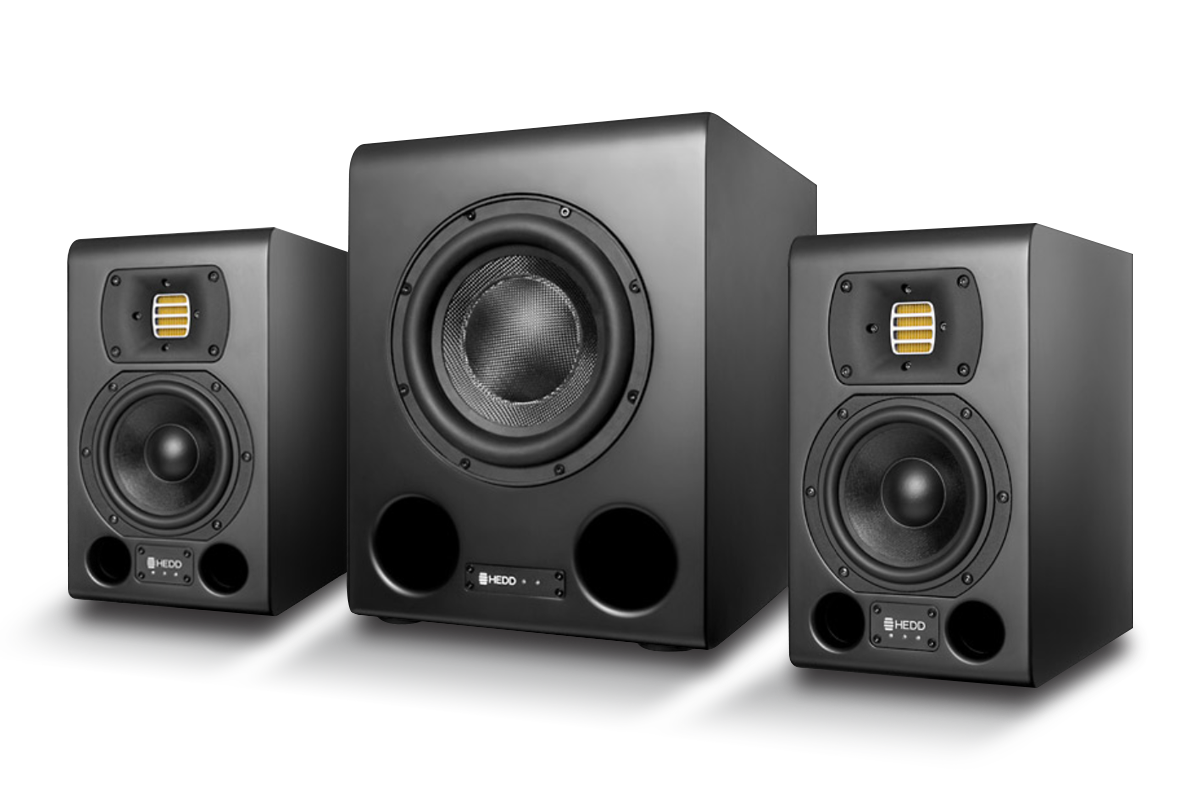
Even more impressive to me was how wonderfully HEDD’s Type 05 MK2 monitors and Bass 08 subwoofer worked for sit-back living-room listening. This combo delivered deep and well-controlled bass, thrilling dynamics, superb imaging, and commendable neutrality throughout the audioband.
For less than three grand, you get a superbly integrated, fully active sat-sub system with 700W of built-in amplification and a specified frequency response of 24Hz-40kHz, -3dB. Combine these HEDD speakers with a streaming DAC-preamp and you have a killer system. That’s outstanding value.
. . . Gordon Brockhouse
Associated Equipment
- Sources: exaSound e32 Mk.II DAC, NAD C 658 streaming DAC-preamp
- Active loudspeakers: Elac Navis ARF-51
- Speaker stands: Monoprice Monolith (floor, 28″H), IsoAcoustics ISO-155 (desktop)
- Interconnects (balanced): AmazonBasics (6′, XLR), Benchmark Media Studio&Stage (6′, 15′, XLR)
- Computer: Apple MacBook Pro (early 2015) running Audirvana 3.5.44 and Roon
- USB link: AudioQuest Cinnamon (2m)
HEDD Type 05 MK2 Active Loudspeakers
Price: $1598/pair USD in black; for white, add $120/pair USD.
HEDD Bass 08 Powered Subwoofer
Price: $1199 USD.
Warranty (both): Two years parts and labor.
HEDD Audio GmbH
Salzufer 13/14
10587 Berlin
Germany
Website: www.hedd.audio





